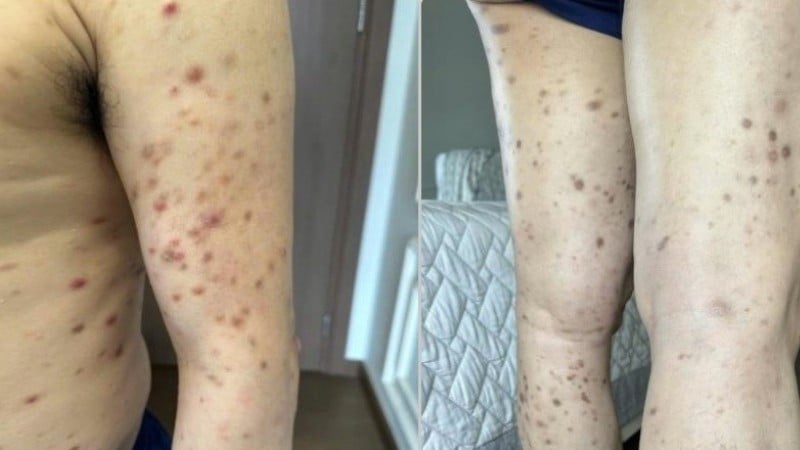
Patient B.D.X, 54 years old, came to the Hematology and Blood Transfusion Center - Bach Mai Hospital with small, slightly raised papules on the skin, first appearing on the back and then gradually spreading to the abdomen, chest, arms, and legs. Some papules showed signs of mild necrosis, black scabs, leaving dark, shrunken scars.
Previously, the patient had been examined and treated at many facilities, including abroad, with diagnoses such as non-specific dermatitis or roundworm infection. Despite using many methods such as topical corticosteroids, oral retinol, UV radiation... the patient's condition still did not improve.
Only when examined at Bach Mai Hospital, doctors determined the true nature of the disease: lymphoid papulosis - a rare chronic lymphoproliferative disorder, capable of progressing to malignant lymphoma if not carefully monitored.
Associate Professor, Dr. Nguyen Tuan Tung - Deputy Director of Bach Mai Hospital, Director of the Center for Hematology and Blood Transfusion emphasized that this is a typical case showing that there are skin diseases that have a long, persistent progression, seemingly benign but have the potential for malignancy in terms of histopathology. Accurate detection and diagnosis require close coordination between the specialties of Dermatology, Hematology, Pathology and Immunology.
Lymphoid papulosis is a very rare disease, only about 1.2-1.9 cases per 1 million people, usually occurring in middle-aged people (about 50 years old). The disease manifests as recurrent necrotic papules that heal spontaneously, but can progress to malignant lymphoma in 10-20% of cases.
The peculiarity of the disease is the contrast between the external manifestations and the histological nature. On the surface, the patient has only a few papules, mild itching, self-healing and leaving scars. However, skin biopsy and immunohistochemical staining show abnormal, CD30-positive lymphocytes, including Reed-Sternberg cells, a characteristic often seen in Hodgkin lymphoma.
In the case of patient B.D.X, the lesion was classified as type A lymphoid papulosis, that is, there was deep abnormal lymphoid infiltration, but no invasion of the marrow or other organs.
In these cases, initial treatment may be topical corticosteroids, retinol, or observation. But when the disease recurs, is widespread, causes cosmetic disfigurement, or has a risk of malignancy, low-dose immunosuppressants such as Methotrexate are indicated.
The patient is currently responding well after 4 months of Methotrexate treatment, the old lesions are gradually healing, no new papules appear. However, close monitoring is still needed because the disease can recur when the drug is stopped.
Doctors recommend that people should not take prolonged skin lesions lightly. If you see unexplained red, scaly or dark spots on your skin that last for more than 3 months, see a specialist.
In particular, it is necessary to avoid using topical medications for a long time, especially those containing corticosteroids, because it can mask symptoms and make the disease more difficult to detect.
Everyone needs to proactively monitor their skin and that of their loved ones, especially middle-aged and older people - an age group susceptible to rare skin diseases.
If you suspect a persistent abnormality, please visit a reputable medical facility with a Dermatology, Hematology or Pathology specialty.
Lymphoid papulosis is a rare disease with misleading skin manifestations but potentially serious risks. Increased vigilance, understanding and early detection will help patients avoid serious consequences and receive appropriate and timely treatment.
Source: https://nhandan.vn/nguy-co-mac-benh-hiem-tu-ton-thuong-da-dai-dang-post898818.html






















![[Photo] Nghe An: Provincial Road 543D seriously eroded due to floods](https://vphoto.vietnam.vn/thumb/1200x675/vietnam/resource/IMAGE/2025/8/5/5759d3837c26428799f6d929fa274493)











































































Comment (0)